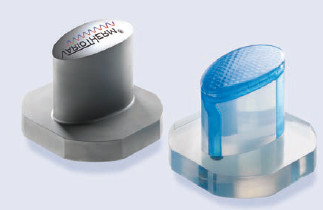Economic solutions for tooling and mould-making
Securing competitive advantages and getting to the market faster is the name of the game nowadays in almost all sectors of industry. As a renowned supplier to the plastics-processing industry and in aluminium die-casting, Concept Laser GmbH benefits from many years of experience. The use of mould inserts with conformal cooling delivers quality optimisation while reducing the unit costs at the same time.
Metal Machine Solutions using LaserCUSING® Technology, a cutting edge technology from Concept laser is now available in Australia and New Zealand from Objective3D. The term LaserCUSING® – made up of the letter C from Concept Laser and the word FUSING for „complete melting“ – describes the technology of the future. The fusion process with patented „stochastic exposure“ generates complex component geometries layer by layer using 3D CAD data. LaserCUSING® opens up unimagined possibilities. New product ideas and mould inserts which can be subjected to high mechanical and thermal loading can already be produced today. Individually, fl exibly, quickly and cost-effectively!
LaserCUSING® MOULD INSERT DELIVERS QUALITY BENEFITS
MATERIAL CHOICES
The LaserCUSING® machines are suitable for processing the following material groups: Stainless steels, hot-work steels, stainless hot-work steels and nickel based alloys
APPLICATIONS
If you are interested to learn more about our latest Metal Machine offering and what this leading edge technology can do for you, visit us at National Manufacturing Week 2016 in Sydney. Our 3D Printing Solutions Consultant, John Whinnen, will be at the Amaero Additive Manufacturing Stand at the following dates and times. If you would like to lock in a date and time to meet John at the show, please feel free to call him at 0408 134 443 or email him at john@objective3d.com.au

Stand 1604 (Amaero Additive Manufacturing)
Wednesday, 11th May, 10am - 3pm
Thursday, 12th May, 10am - 3pm
Friday, 13th May, 10am-4pm
Securing competitive advantages and getting to the market faster is the name of the game nowadays in almost all sectors of industry. As a renowned supplier to the plastics-processing industry and in aluminium die-casting, Concept Laser GmbH benefits from many years of experience. The use of mould inserts with conformal cooling delivers quality optimisation while reducing the unit costs at the same time.
Metal Machine Solutions using LaserCUSING® Technology, a cutting edge technology from Concept laser is now available in Australia and New Zealand from Objective3D. The term LaserCUSING® – made up of the letter C from Concept Laser and the word FUSING for „complete melting“ – describes the technology of the future. The fusion process with patented „stochastic exposure“ generates complex component geometries layer by layer using 3D CAD data. LaserCUSING® opens up unimagined possibilities. New product ideas and mould inserts which can be subjected to high mechanical and thermal loading can already be produced today. Individually, fl exibly, quickly and cost-effectively!
LaserCUSING® MOULD INSERT DELIVERS QUALITY BENEFITS
- Shortening of the manufacturing time for mould inserts
- Shorter reworking time, since there is no rough machining process required.
- Less warping and shrinkage holes: Increase in quality and/or reduction in the scrap rate.
- High-quality product delivers considerable competitive advantage.
- Cycle time saving of 20-30% and more means: Lower unit costs
MATERIAL CHOICES
The LaserCUSING® machines are suitable for processing the following material groups: Stainless steels, hot-work steels, stainless hot-work steels and nickel based alloys
APPLICATIONS
- LaserCUSING® mould insert for aluminium die-casting (oil pump housing) manufactured on M1 cusing / material CL 50WS (1.2709) / measurable advantages thanks to integration of a conformal cooled tool insert in cavity 2: signifi cantly improved product quality thanks to the reduction of cavity formation. 50% less scrap rate based on the target error characteristic. Warping on the cast part considerably reduced. Time and cost saving.
- LaserCUSING® mould insert for an injection-mould to produce lenses for sport glasses in serial production manufactured on M1 cusing / material CL 50WS (1.2709) / measurable advantages thanks to the patented conformal surface cooling: reduction in the cycle time and quality optimisation.
- LaserCUSING® mould insert for vacuum cleaner lid injection-mould in serial production manufactured on M1 cusing / material hot-work steel CL 50WS (1.2709) / measurable advantages thanks to patented conformal parallel cooling: quality optimisation, reduction in the cycle time and unit costs.
If you are interested to learn more about our latest Metal Machine offering and what this leading edge technology can do for you, visit us at National Manufacturing Week 2016 in Sydney. Our 3D Printing Solutions Consultant, John Whinnen, will be at the Amaero Additive Manufacturing Stand at the following dates and times. If you would like to lock in a date and time to meet John at the show, please feel free to call him at 0408 134 443 or email him at john@objective3d.com.au

Stand 1604 (Amaero Additive Manufacturing)
Wednesday, 11th May, 10am - 3pm
Thursday, 12th May, 10am - 3pm
Friday, 13th May, 10am-4pm



